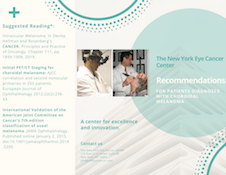Click on the Brochure to Read it in Full!
About New York Eye Cancer Center:
The New York Eye Cancer Center is designed to be a responsive and caring environment for those afflicted with eye cancer. We strive to be your and your doctor’s first choice for eye cancer care. Dr. Finger is an internationally recognized eye cancer specialist and believes in excellence through innovation.
Read More »
Read More »
Chemotherapy Eye Drops:
Dr. Finger has found that even large conjunctival squamous carcinomas can be managed by performing a simple, painless in office biopsy to confirm the diagnosis. Then Dr. Finger prescribes one of 3 types of chemotherapy eye drops, until he finds the drug that melts away and cures the squamous cancers.
Read More »
Read More »
Finger Designed Eye Plaques:
Dr. Finger has designed specially shaped radiation devices for treatment of intraocular melanoma. These devices work to limit the radiation to the normal parts of the eye, save vision and destroy the cancer in almost all cases.
Read More »
Read More »
Why Choose Palladium-103:
Dr. Finger was the first to use palladium-103 seeds in ophthalmic radiation plaques in treatment of intraocular melanoma and retinoblastoma. He chose to switch from iodine-125 seeds because he knew and later proved that the lower…
Read More »
Read More »
Finger Outcomes Reporting:
Don’t you want to know the success rates of the surgeon you are about to pick? In 2017, Dr. Finger started an internal program at The New York Eye Cancer Center to average almost all patients he…
Read More »
Read More »
Finger International Multi-center Cooperation:
Dr. Finger has long recognized that in order to better understand rare eye tumors, the eye cancer community of physicians had to: 1) Speak Ocular Tumor (use the same “AJCC-UICC” TNM descriptions for each kind of tumor…
Read More »
Read More »
Finger Small Incision Biopsy:
Dr. Finger realized the advantages of micro-invasive biopsy for intraocular and orbital tumors. Borrowing aspiration-cutter technology from the retinal specialists, Dr. Finger created safe, effective methods of biopsy for choroidal, ciliary body, iris, and…
Read More »
Read More »
Anti-VEGF For Radiation Maculopathy:
In 2006, Dr. Finger discovered that anti-VEGF drugs could be injected into eyes suffering from sight-limiting radiation retinopathy and optic neuropathy. Since that time, he published his 10-year experience. He has found that these drugs typically suppress…
Read More »
Read More »
Anti-VEGF Injections How To:
Dr. Finger’s intravitreal injection routine enables maximum efficacy for the anti-VEGF treatment. Dr. Finger himself introduced angled self-sealing needle punctures. The idea in doing this as opposed to the…
Read More »
Read More »
Finger About Enucleation:
All About The Surgery to Remove an Eye. At The New York Eye Cancer Center, less than 6% of patients have their eye removed as treatment for their intraocular tumor. Most of those are due to the patient’s…
Read More »
Read More »
Finger Staging Techniques:
Dr. Finger realized that all eye cancer specialists must be able to define and communicate the severity of radiation damage within the eye. Only then can they compare their methods of diagnosis and treatment. Read More »
Small Choroidal Melanoma:
One of the most difficult decisions patients and doctors make is when to treat small choroidal melanomas. This is because all treatments carry the risk of affecting visual acuity. This brochure explains most of the risks and potential benefits… Read More »

If You Have Been Diagnosed with Choroidal Melanoma:
If you have been diagnosed with choroidal melanoma, you need to have a medical evaluation to make sure the tumor has not already spread to other parts of your body….
Read More »
Read More »

The Importance of Radiation Types:
Palladium-103, Iodine-125, or Ruthenium-106? Why is the radiation type so important?
Read More »
Read More »

MOST: Correctly Identifying Melanoma
Dr. Finger invented a way to remember the three most common characteristics of choroidal Melanoma: Orange pigment, subretinal fluid and a thickness typically greather than 2.0 mm – key to a correct diagnosis.
Read More »
Read More »





















